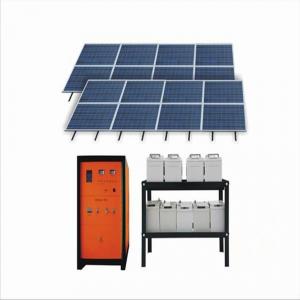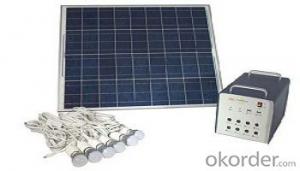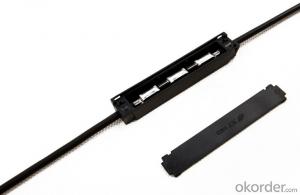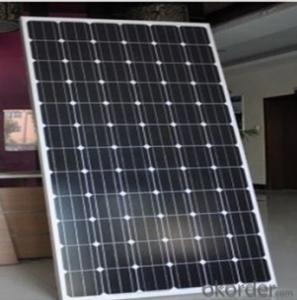CNBM 150W Solar Home System High Quality
- Loading Port:
- China Main Port
- Payment Terms:
- TT or LC
- Min Order Qty:
- 500 Sets set
- Supply Capability:
- 200000 Sets per year set/month
OKorder Service Pledge
OKorder Financial Service
You Might Also Like
Details Of CNBM 150W Solar Home System High Quality
Item | EW-SHS150W | ||||||
Solar module | Type | Polycrystalline Silicon | |||||
Item/Qty. | SPS075 -12M / 2pcs | ||||||
Maximum power at STC(Pm) | 75 Wp | ||||||
Optimum operating current(Imp) | 21.6V | ||||||
Short circuit current(Imp) | 4.87A | ||||||
Dimensions l×w×h/Weight | 1195mm × 541mm × 28mm / 8kg | ||||||
Battery | Type | Lead-acid Maintenance-free Rechargeable | |||||
System Voltage | 24V | ||||||
Capacity | 100AH/12V, 2pcs | ||||||
Dimensions l×w×h/Weight | 329mm × 172mm × 229mm / 31kg | ||||||
Charge Controller | System Voltage | 24V | |||||
Max. module input short circuit current | 6A | ||||||
Dimensions l×w×h/Weight | 130mm × 88mm × 39mm / 0.165kg | ||||||
Inverter | Type | High frequency pure sine wave | |||||
Item/Qty. | SK300-224 | ||||||
Continuous Output Power | 300W | ||||||
Surge Rating | 600W | ||||||
Output Voltage | 220V / 50Hz | ||||||
Protection | Overload, Short circuit, Reverse polarity(FUSE) , Over/under input voltage, Over temperature. | ||||||
Dimensions l×w×h/Weight | 224mm × 164mm × 78mm / 1.8kg | ||||||
Control Box | Material | Steel box of zinc-plated and lacquer-coated | |||||
Color | Gray | ||||||
Dimensions l×w×h/Weight | 560mm × 550mm × 600mm / 23kg | ||||||
Capacity of Load: | Load | specification | Load power | number | Working hours/day | Expend/day | |
Saving light | 11W | 1 | 6 | 66Wh | |||
Television | 21inch | 70W | 1 | 2 | 140Wh | ||
Television receiver | 25W | 1 | 4 | 100Wh | |||
Total | 106W | 306Wh | |||||
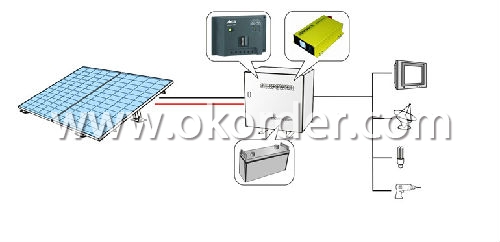
Packaging & Delivery Of CNBM 150W Solar Home System High Quality
Packaging & Delivery Of CNBM 150W Solar Home System High Quality | |
Packaging Detai | Packaging Detail:Export Carton and Pallet or under customer request. |
Delivery Detail:10-20days | |
Our advantages
•Professional products,brand power,group advantage.
•We can do OEM and ODM, and we have our own talented R&D teams
•All our products are easy to be used and convenient in maintanence
•Strong technical team is ready to work for you.
•Factory with 70000square meters,real factory price,top service.
- Q:Can solar energy systems be installed on agricultural land?
- Yes, solar energy systems can be installed on agricultural land. In fact, many farmers are increasingly embracing solar energy as a way to generate clean power and reduce their carbon footprint. Solar panels can be installed on unused or marginal land without affecting agricultural activities, providing a dual benefit of sustainable energy production and continued farming.
- Q:Can solar energy systems be used for powering electric car wash systems?
- Solar energy systems have the capability to operate electric car wash systems. Utilizing photovoltaic panels, solar energy systems convert sunlight into usable electricity. This electricity can then be employed to power a variety of electrical devices, such as car wash systems. By strategically placing solar panels on the roof of a car wash facility or a nearby structure, the generated solar power can be directly harnessed to operate the electric motors, pumps, and other necessary equipment for a car wash system. This not only diminishes the dependence on traditional grid electricity but also aids in reducing operational expenses and minimizing the carbon footprint of the car wash facility. Moreover, solar energy systems have the ability to store surplus energy in batteries, ensuring uninterrupted operation even during periods of limited sunlight or at night.
- Q:Can solar energy systems be used for powering airports?
- Yes, solar energy systems can be used for powering airports. Solar panels can be installed on the roofs of airport buildings or on nearby ground areas to generate electricity. This renewable energy source can help reduce the carbon footprint of airports and provide a sustainable power solution. Additionally, solar energy systems can also be used to power auxiliary equipment such as runway lights and navigation aids, making airports more energy-efficient.
- Q:Can solar energy systems be used in areas with high levels of saltwater exposure?
- Yes, solar energy systems can be used in areas with high levels of saltwater exposure. However, it is important to choose the right materials and components that are resistant to corrosion caused by saltwater. Additionally, regular maintenance and cleaning may be required to ensure optimal performance and longevity of the solar panels.
- Q:Can solar energy systems be used for water desalination?
- Yes, solar energy systems can be used for water desalination. Solar-powered desalination systems use solar energy to power the desalination process, typically through solar panels that generate electricity or solar thermal collectors that heat water. This renewable energy source can provide a sustainable and environmentally friendly solution to desalinate seawater or brackish water, making it suitable for human consumption or agricultural purposes.
- Q:Can solar energy systems be used in areas with limited access to solar energy financing options?
- Yes, solar energy systems can still be used in areas with limited access to solar energy financing options. There are alternative funding options available such as grants, government incentives, and community-based financing models that can help make solar energy systems more affordable and accessible in such areas. Additionally, advancements in technology and decreasing costs of solar panels have made it more feasible for individuals and communities to invest in solar energy systems without relying solely on traditional financing options.
- Q:Can solar energy systems be integrated with existing electrical systems?
- Yes, solar energy systems can be integrated with existing electrical systems. This is done by connecting the solar panels to the existing electrical grid through an inverter, which converts the DC power generated by the panels into AC power that can be used by the electrical system. The integration allows for the simultaneous use of solar energy and grid power, providing a more sustainable and efficient energy solution.
- Q:Can a solar energy system be installed in an off-grid location?
- Certainly! Solar energy systems can be installed in off-grid locations. Off-grid locations are actually perfect for solar energy systems because they often don't have access to traditional sources of electricity. In off-grid solar energy systems, there are solar panels, batteries, charge controllers, and inverters. The solar panels gather sunlight and convert it into electricity, which is then stored in batteries for use when there is no sunlight. The charge controller manages the flow of electricity between the solar panels and the batteries, and the inverter changes the stored DC electricity into AC electricity to power appliances and devices. All these components work together to offer a dependable and sustainable electricity source in off-grid locations, reducing reliance on fossil fuels and minimizing environmental impact.
- Q:What is the impact of shading on solar energy systems?
- Shading has a significant impact on solar energy systems as it can reduce the overall efficiency and output of the system. When a solar panel or array is shaded, it blocks the sunlight from reaching the photovoltaic cells, resulting in a decrease in electrical generation. Even partial shading, such as from trees or nearby buildings, can have a noticeable effect on the system's performance. It is important to design and install solar energy systems in areas with minimal shading to maximize their energy production potential.
- Q:Can solar energy systems be used for powering schools or educational institutions?
- Yes, solar energy systems can be used to power schools or educational institutions. In fact, many schools and educational institutions around the world are adopting solar energy systems as a sustainable and clean source of power. Solar energy systems, such as solar panels, can be installed on the roofs of school buildings or in open spaces on the school campus to harness the power of the sun. This renewable energy source can generate electricity to meet a significant portion of the school's power needs. There are several benefits to using solar energy systems in schools. Firstly, solar power is a clean source of energy that does not produce harmful emissions or contribute to air pollution, thus helping to reduce the carbon footprint of the educational institution. Additionally, solar energy systems can help schools save money on their electricity bills in the long run, as they can generate electricity for free once the initial installation costs are recovered. These savings can be reinvested in educational resources or programs. Moreover, integrating solar energy systems into schools can provide valuable educational opportunities for students. By utilizing solar power, schools can educate their students about renewable energy, climate change, and the importance of sustainable practices. Students can learn about the science behind solar energy, the benefits of clean energy sources, and the role they can play in promoting a greener future. Furthermore, solar energy systems can also serve as a backup power source during power outages or emergencies, ensuring uninterrupted power supply to the school, especially during critical times such as exams or in areas with unreliable electricity infrastructure. In conclusion, solar energy systems can indeed be used to power schools or educational institutions. They offer numerous benefits, including reduced carbon emissions, cost savings, educational opportunities, and backup power capabilities. By embracing solar power, schools can demonstrate their commitment to sustainability, inspire students, and contribute to a cleaner and greener future.
1. Manufacturer Overview |
|
|---|---|
| Location | Jiangsu, China |
| Year Established | 2004 |
| Annual Output Value | Below US$1 Million |
| Main Markets | Australia;Asia;South East Asia; South America;North America; Europe;Africa |
| Company Certifications | ISO 9001:2008; CE; TUV; UL |
2. Manufacturer Certificates |
|
|---|---|
| a) Certification Name | |
| Range | |
| Reference | |
| Validity Period | |
3. Manufacturer Capability |
|
|---|---|
| a)Trade Capacity | |
| Nearest Port | Shanghai |
| Export Percentage | 1% - 10% |
| No.of Employees in Trade Department | 200-300 People |
| Language Spoken: | English;Chinese |
| b)Factory Information | |
| Factory Size: | Above 8,000 Square meter |
| No. of Production Lines | 6 |
| Contract Manufacturing | OEM Service Offered;Design Service Offered |
| Product Price Range | Average |
Send your message to us
CNBM 150W Solar Home System High Quality
- Loading Port:
- China Main Port
- Payment Terms:
- TT or LC
- Min Order Qty:
- 500 Sets set
- Supply Capability:
- 200000 Sets per year set/month
OKorder Service Pledge
OKorder Financial Service
Similar products
New products
Hot products
Hot Searches
Related keywords
